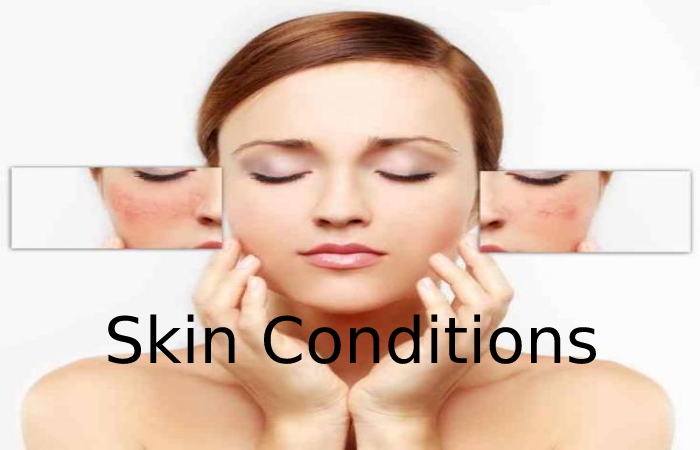Skin disorders vary widely in terms of symptoms and severity. They can be passing or permanent, and they can be painless or painful. Some of its causes are circumstantial, while others can be genetic. Some skin conditions are mild, and others can be life-threatening.
While most skin disorders are mild, others indicate a more severe problem. Contact your doctor if you reason you have any of these common skin problems.
Some of the most common skin conditions began by infections, and others result from genetic factors combined with environmental factors. This article gives you some examples of skin diseases caused by different factors, describing their symptoms, treatments, and ways to prevent them.

Table of Contents
Skin and Dermatology
To better understand the characteristics of the skin, we recommend that you read previous articles such as Rare dermatoses and their relation to genetics or Basic care for sensitive skin. We explain in detail, among other things, that the skin is the largest organ in the human body and that complete up of three layers: the epidermis, the dermis, and the hypodermis. The skin performs several functions, among which we can highlight its role as a protective barrier that defends our body against attacks from external agents such as viruses and bacteria, among others.
This protective ability can be affected if something inflames or irritates the skin. The discipline is responsible for studying, preventing, and treating the various pathologies that affect the skin, and the care of healthy skin is called dermatology. These pathologies that move the skin can range from primary to systemic diseases established through the skin. Most skin conditions are not severe. However, they usually have uncomfortable symptoms that can influence the patient’s mood, as most are generally visible.
Common Skin Diseases and their Origin
The origin of skin diseases can be very diverse. As we mentioned above, some result from fungal or viral infections, while others involve environmental and genetic factors or can even begin with immune issues.
Here are some of the most joint skin conditions, including one that has increased alarmingly in recent years: melanoma, a type of skin cancer.
Vitiligo
The spots have well-defined edges, and these sometimes appear darker or reddish. In addition, vitiligo generally causes the early appearance of gray hair, especially in places.
The disease occurs due to the destruction or dysfunction of melanocytes, which are the compartments that crop melanin (the pigment that determines the color of hair and skin). Hence, although it affects all It types, it is most noticeable in dark skin tones.
It is not a contagious disease or a severe prognosis. However, it can cause sunburn or It cancer, among other complications. In addition, It with vitiligo rarely regains its color, and most of the time, the lack of pigmentation spreads to various parts of the body.
Once vitiligo is diagnosed, through blood tests or a biopsy, may start treatments to balance It tone, such as:
- Depigmentation of unaffected areas.
- Medicines with corticosteroid creams.
- Activation of melanocytes by exposure to UVA rays.
Operation
The cause of the disease is still strange, although much research indicates that the culprit could be a combination of genetic and environmental components.
Specifically, research indicates that vitiligo has a polygenic mode of inheritance, which means that multiple alleles contribute to the genetic risk of the disease.
The relationship between genetics and vitiligo development has long been suspect. And also as first-degree relatives of people with this disease have a higher rate of vitiligo than the general population. More specifically, the siblings of those affected have a prevalence of 6%, which increases to 23% in the case of twins.
Skin Cancer
This type of cancer occurs when abnormal skin cells grow out of control due to damage to their DNA, mainly caused by ultraviolet radiation.
Although it is more common in areas of the body exposed to the sun, such as the face, neck, chest, arms, and legs, it can also occur in the regions that are generally not exposed, such as the palms of the skin—hands or under the fingernails.
Among the types of cancer that exist, melanoma is the most dangerous because . And also it can spread to internal organs and, therefore, be life-threatening in its advanced stage.
Detected early, it is usually curable, so you should pay special attention to its first manifestations, which include:
Large brownish spots with more minor dark spots.
Moles that change the size, color, or bleed.
Small lesions with irregular edges and reddish, white, or bluish parts.
Lesions go with itching or burning.
Dark lesions on the tributes of the hands, soles of the feet. And also on the mucous membranes of the mouth, nose, vagina, or anus.
The amount of melanoma cases has tripled in the past 20 years. The proliferation of outdoor activities or tanning salons is some of the reasons consider to explain this sharp increase.
The primary treatment for this type of It cancer is surgery to remove the malignant growth. If the cancer is advance, chemotherapy, radiation therapy, or immunotherapy froze to slow the progression of the disease.
Environmental and hereditary factors are involved in the development of this disease. In about 10% of cases, melanoma occurs in several members of the same family. These familial cases are usually due to hereditary genetic changes that increase the risk of developing this type of cancer.
